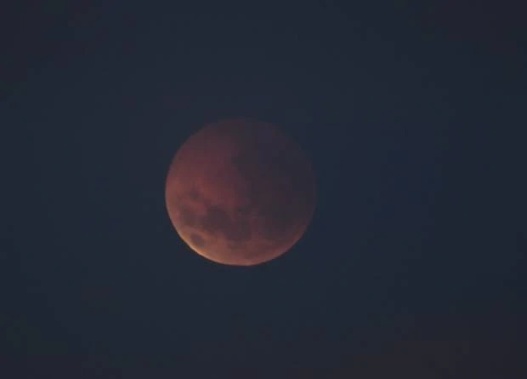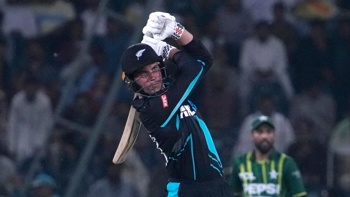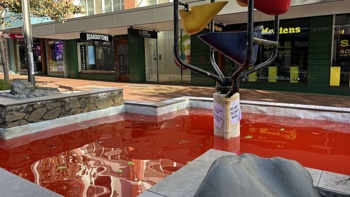
Kiwi star-gazers are waking up and turning their eyes to the skies to get a once-in-a-lifetime glimpse at a "blood moon" like no other.
People across the country -weather permitting - will be able to view a rare celestial event called a selenelion this morning.
This occurs when an eclipsed moon can be seen on one horizon, while the rising sun can be observed on the other.
During the total eclipse - which began at 7.30am New Zealand time when the sun rises - the moon was much fainter than it usually appeared, and was coloured between dark brown and blood red.
To witness it, Dr Duncan Steel, of Otago's Centre for Space Science Technology, said obviously clear skies are needed.
"You need to be in a location with a view to where the moon will set in the west-south-west and also to where the sun will rise in the east-north-east," he said.
The lunar eclipse from Gisborne, New Zealand. :) pic from using my phone and telescope. #lunareclipse #lunareclipse2018 #NewZealand #astronomy pic.twitter.com/aommNypM42
— Becca 🇳🇿 (@Timaeus_NZ) July 27, 2018
MetService's radar is showing rain this morning in Auckland, along New Zealand's west coast and Invercargill in the far south but fine weather across much of the rest of the country.
Dr Steel said the way to see the "blood moon" would be to get a high vantage point.
"The higher you are, the better, because the sun will be barely clearing the horizon as the moon sets in the opposite direction."
It was also better the further south you are with Otago and Southland favoured because the event will last longer.
/arc-anglerfish-syd-prod-nzme.s3.amazonaws.com/public/VAIRIJ22CZGCROHKCDEZAX5ZQY.jpg?width=519&height=389)
Taken at 6.30am in Aucckland. Photo / Cathy Casey
In Auckland, the eclipse will still be partial as the moon disappeared below the horizon.
For those in areas from Whanganui to Wellington, there was just a slim chance of glimpsing the totally-eclipsed moon as the sun peeked above the horizon.
The opportunity was longer in the southernmost parts of the country.
In Invercargill, there was five minutes between sunrise at 8.12am and moonset shortly after, with the moon entirely within Earth's shadow.
In Dunedin, the interval was reduced to four minutes; in Christchurch, three minutes.
Steel is it rare to be able to see a "blood moon".
Blood moon at Careys Bay, NZ. I stood at the back door to witness the passage of the sun & moon before the two together slipped below the hill. pic.twitter.com/6doHelifyM
— rob allan (@allanrob9) July 27, 2018
"Although there is a lunar eclipse visible from New Zealand every couple of years, on average, being located in the right place to see a celestial peculiarity like a selenelion is much less frequent, and very few people have witnessed one."
The colouration of moon - a spectacle shrouded in ancient superstition - was due to some sunlight leaking through Earth's atmosphere and reaching the moon.
Red light had a better chance of doing so for the same reason the sky was blue - shorter wavelengths were scattered more efficiently by the molecules in our atmosphere."
WOW, that lunar eclipse this morning was incredible! Here it is, setting over Wind Turbine in @Wellington_NZ just now. Hundreds of people up on Mt Vic where I was watching the eclipse. #LunarEclipseLive #lunareclipse2018 pic.twitter.com/SdBQez2xNF
— Te Kawa Robb (@tekawa_robb) July 27, 2018
The first record of any such event dated from 1666 - the same year of the Great Fire of London.
This morning's "blood moon" comes after another treat for stargazers overnight as the Earth lined up directly between Mars and the Sun in what astronomers called the "opposition" of Mars - something that takes place around every two years.
This phenomenon was accompanied with the effect of Mars appearing bigger in the Earth's night sky.
Images from around the world
/arc-anglerfish-syd-prod-nzme.s3.amazonaws.com/public/2N6VA57Y3JBXJGFFXH2KOTANUQ.jpg) Full moon rises over the ancient temple of Poseidon in cape Sounio, about 65 kilometers (40miles) south of Athens. Photo / AP
Full moon rises over the ancient temple of Poseidon in cape Sounio, about 65 kilometers (40miles) south of Athens. Photo / AP
/arc-anglerfish-syd-prod-nzme.s3.amazonaws.com/public/UQVYBAJFMBBK3CQI2VL6VY4H74.jpg)
Take your Radio, Podcasts and Music with you

/arc-anglerfish-syd-prod-nzme.s3.amazonaws.com/public/UJNYMDTVVVC33PLFOTEO5I3ICI.jpg)








